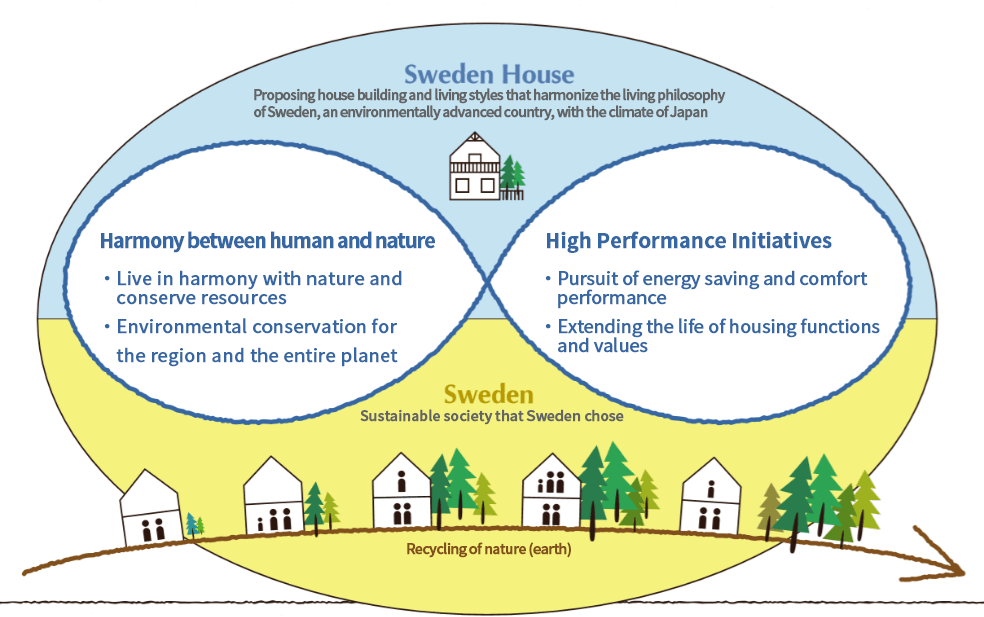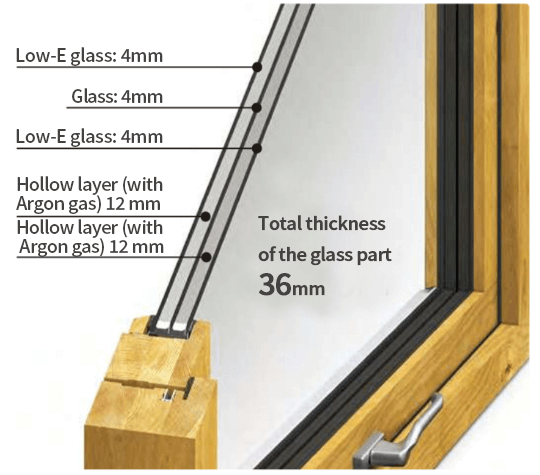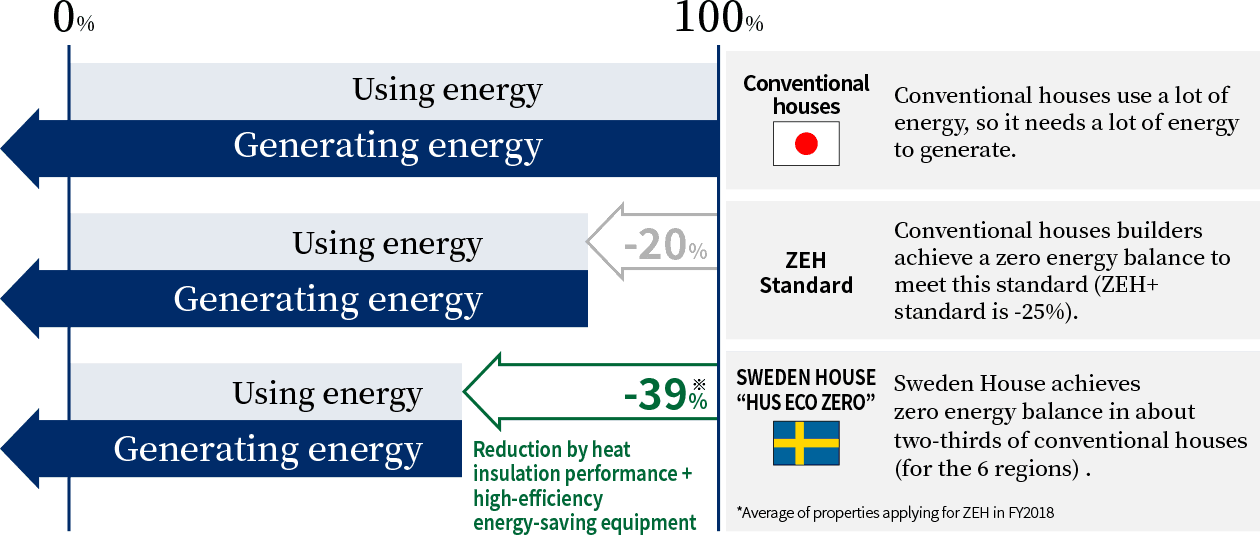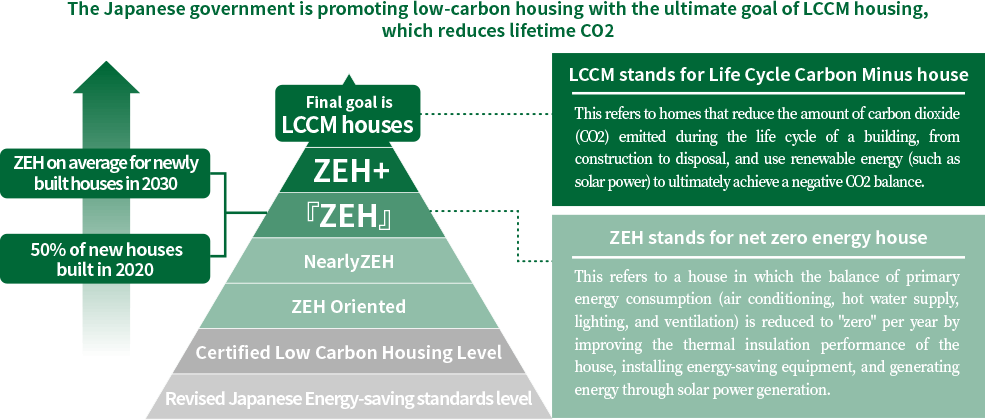CSR/SustainabilityCSR ・ Sustainability
Building to save energy and create comfortable home
Environmental Policy of Sweden House
Based on the housing philosophy of Sweden, an environmentally advanced country, Sweden House promotes the creation of houses with the fragrance of natural wood, the pursuit of energy-saving and comfortable performance, the prolongation of the functions and value of housing, and harmony and integration with the Japanese climate.
With this, we will minimize energy consumption, use clean energy effectively, fix CO2 for a long time, conserve resources, reduce and reuse waste, respect biodiversity, and contribute to environmental conservation in the region and on the planet as a whole.

About Sweden House:
- We will continue to make improvements in response to technological advances and changes in the environment so that we can always build houses with low environmental impact.
- In order to comply with environmental laws, which we consider to be the minimum standards, we will strive to protect the environment by imposing stricter voluntary standards.
- In order to provide houses with low environmental impact, we will eliminate waste in all aspects of our business activities and make effective use of resources.
- We will formulate timber procurement policy to support sustainable forest management and protect biodiversity.
- We will continue to provide environmental education to all our employees to raise their environmental awareness, and we will also request the understanding and cooperation of our environmental policy to our partnership construction companies.
Sweden House’s building
Sweden House makes people and the earth comfortable
Consideration for the global environment must be balanced with consideration for human health and safety, and the "comfort" we aim for is where the two overlap, in terms of being kind to people and to the earth.

Sweden House windows that reduce CO2 emissions
- Dramatically reduces heat inflow and outflow through windows
-

Since the beginning of the company's history, all buildings in Sweden House have been equipped with triple-glazed wooden sash windows as standard. This is because in order to ensure high thermal insulation performance, it is essential to insulate not only the building frame but also the windows, entrance doors, and other openings. The reason why we insist on wooden sashes in particular is that wood is about 1,700 times more insulating than aluminum, and because of its ability to regulate humidity, it is a material that is well suited to the hot and humid climate of Japan. Triple-glazing further enhances the thermal insulation performance. In double-glazing, the hollow layer (containing argon gas) is an excellent insulator. While ordinary double-glazing (two layers of glass) has a 6mm hollow layer, Sweden House has a 12mm hollow layer, and the hollow layer between the three layers of glass is 12mm x 2 = 24mm. The glass itself is 4mm thick (3mm for double glazing). Low-E glass is installed as standard on both the outdoor and indoor sides, halving the inflow of solar heat in summer, and at the same time cutting harmful ultraviolet rays by about 78%.
- One building reduces CO2 emissions equivalent to 33 beech trees
-
How much of a difference in thermal insulation performance is there between the wood sash triple-glazed windows of Sweden House and windows with single-glazed aluminum sashes? We estimated the amount of CO2 reduction due to the difference in windows. If we focus only on the thermal insulation performance of the windows of one Sweden House, the amount of CO2 reduction is equivalent to the amount of CO2 absorbed by a beech tree in one year, about 33 trees. When converted to the number of Sweden Houses built nationwide (approximately 34,307 as of the end of March 2019), this is equivalent to about 1.13 million trees.
It is possible to achieve both comfort and energy savings just by living a normal life
- Comfortable living with about 40% less energy
-
In recent years, the energy-saving performance of heating and cooling equipment has become much higher, but if the insulation performance of the building is low, a lot of energy will be required even if the latest equipment is used. Sweden houses use
- Thick insulation material that envelops the entire house
- Wooden sash triple-glazed windowns
- High air density construction
thus, Sweden house has high quality energy-saving performance with a standard specification. This prevents the effects of heat and cold from the outside air, while minimizing temperature changes throughout the house.
Sweden House allows you to live comfortably with about 40% less energy than the primary energy consumption* of an ordinary house.- Amount of energy used by the entire houses
- Sweden House can meet ZEH+ performance with standard specifications.

- One step ahead in zero energy housing
-
The Japanese government is aiming for a low-carbon society, and in the field of housing, it is promoting energy conservation and CO2 reduction in homes in order to reduce energy consumption and CO2 (carbon dioxide) emissions. These goals include ZEH (Net Zero Energy House) and LCCM (Life Cycle Carbon Minus) homes (see figure).
In order to realize “ZEH”, the following 3 elements are necessary:- High insulation outer skin
- High-efficiency energy-saving equipment
- Energy-creating equipment such as solar power generation
those three elements of energy-generating equipment are necessary. Sweden House, with its high airtightness and high heat insulation, greatly satisfies the ZEH heat insulation standard (UA value 0.60 = 4-7 regions) with its standard specifications (UA value 0.38 = national average for FY2018), so it can greatly reduce the energy used and reduce the annual energy balance to zero with less solar power generation. The government's ultimate goal for LCCM homes is to save CO2 from the time of construction to the time of disposal, resulting in a negative CO2 balance over the lifetime of the home. Since Sweden House has high thermal insulation performance in the building itself, it is possible to obtain LCCM housing certification by combining high-efficiency energy-saving equipment and solar power generation systems. Sweden House believes that the basic performance of the house itself is important, not the equipment, and since its establishment in 1984, we have been using the One Grade High Spec as our standard specification. It is possible to achieve a zero energy balance for new homes as well as for existing Swedish houses.
- Image of low-carbon housing

